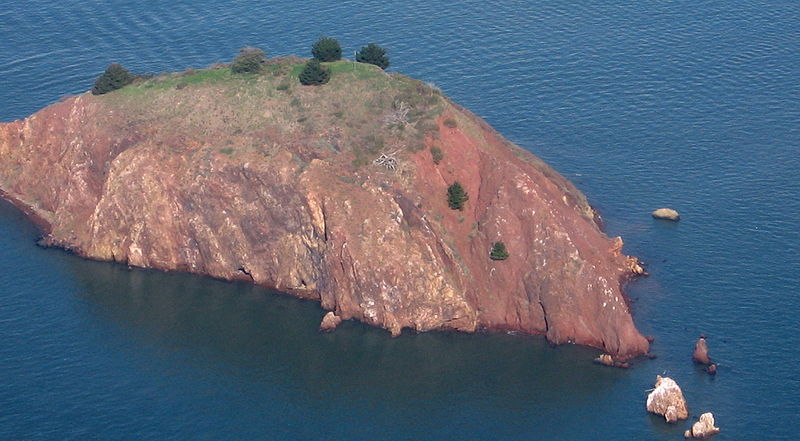The lone private island in San Francisco Bay has languished on the market for the last four years, most recently listed for more than US $20M. According to its owner, the island may hold a wealth of resources for investors – however, major challenges stand in the way.
A small islet under 6 acres in size, Red Rock Island is the only privately-owned island in San Francisco Bay – in fact, one of just five islands in total. A small peaked mountain painted in a dramatic red hue, the isle is a famous sight viewed every day by tens of thousands of commuters crawling through rush-hour traffic on the Richmond-San Rafael Bridge. Listed by Steven Higbee, a local real estate broker, the property has a price tag of US $22M – including mineral rights.
The past two years have given rise to commodity shortages across the world, and according to one of the owners of Red Rock, this may give the island a unique advantage on the market. Mr. David Glickman, who first purchased the island in 1964 while working in San Francisco as a lawyer, now resides in Thailand and runs business dealing in precious gemstones like emeralds, rubies and sapphires. Based on his many years of research, he believes that Red Rock has a unique composition that makes it a rare gem of its own.
The listing price of US $22M includes all mineral rights to the island: it was formerly listed at $10M without any mineral rights, but the owners (there are currently two other partners aside from Mr. Glickman) felt that this confused prospective buyers. And from the island’s history described on Mr. Glickman’s website (http.redrockisland.homestead.com), it is clear that mining has long been the focus for past owners – and even some passing sailors.
Throughout the late 19th century, Norwegian and Swedish sailors heading home from the San Francisco port would stop at the island to load its rust-red rock for ballast, then make a tidy profit by selling it to paint manufacturers on arrival. They absconded with several thousand tons before the practice was stopped by the US government, and they and other trespassers left behind a network of hollowed-out caves, today a refuge for bats and seabirds.
Dating from the early 20th century, extensive mineral surveys were made of the island by local police detective Albert Reihl, who initially came to the island searching for caches of weapons rumoured to be hidden in the island’s cave networks. Together with a partner, he decided to file a claim to mine the property. According to Mr. Glickman, in addition to other surveyed minerals the island also contains an estimated one million tons of a type of rock known as “riprap”, which is commonly used for construction in Northern California but is now in such short supply that it must be expensively barged in from Canada. He suggests that at a price of $30-$50 per ton, this rock may help cover the cost of the island and fund future developments.
Also found on the island is manganese ore, in heavy demand as a component of alloyed steel and aluminum. It is this metal that gives the island’s rock its distinctive rich, reddish-yellow coloration. Recent events such as an upward inflationary pressure on industrial commodities, and the belief that large amounts of steel will be required for the rebuilding efforts in Japan following the country’s devastating earthquakes, have led to soaring prices for manganese oxide.
Another valuable component of the island, according to Mr. Glickman, is a heavy schist deposit in the island’s core, a rare rock strong enough for building roads. It remains to be seen, however, if mining on the island would prove viable. A prime challenge to development is the island’s situation within three separate California jurisdictions – the city of Richmond, and Contra Costa and Marin counties – which leads to fears that gaining joint approvals for development would pose serious difficulties.
With a new era of environmental protection for sensitive island ecosystems, the potential for dramatically altering the island through mining also seems dubious; especially a strip-mining venture that would essentially remove the island’s top, leaving a flat plateau for development, or hollow out the island’s core, to remove the layers of schist from within. Mr. Glickman’s own plans to level the island and construct a casino and hotel were blocked by the City of Richmond decades ago.
There is a remaining prospect for the island, one that would be applauded by local residents – to put the island firmly in public hands, and treated as a valued landmark. This poses challenges of its own; a recent spate of rumours that the East Bay Regional Parks System was an interested bidder on the island were proved false, and the high price is likely to be the main impediment to purchase by conservation groups or the cash-strapped government. However, with all of the many barriers to development, it appears likely that Red Rock will remain in its current state for the indefinite future – even without special protection.



